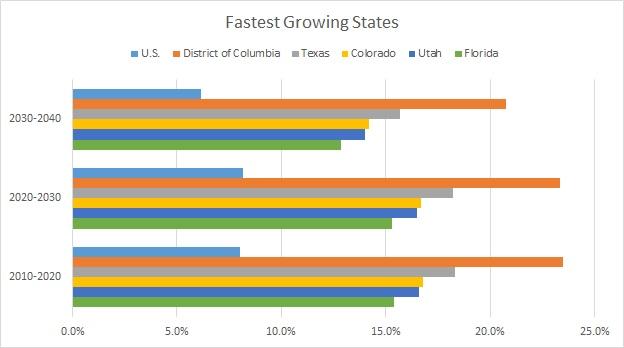National population projections: Growing but slowing

Our new population projections over 2020, 2030, and 2040 for the nation as well as the 50 states and District of Columbia were released today. Looking forward, the U.S. population is expected to reach 383 million by 2040, but the rate of growth is projected to slow down from nearly 10% over the 2000-2010 decade to 6% between 2030-2040. Similar trends are also expected from most states.
The geographic distribution of this growing population also tells an interesting story. Back in 2000, six of the top ten largest states belonged to the North. By 2040, five of the top ten are expected to be in the South. The slowing down of the northern states along with rapid population growth in the south and west, means that over time the country will become more Southern and Western. This trend in regional population distribution is already evident from the shift in the mean center of population for the United States charted by the Census Bureau from 1790 to 2010, and will continue south-westward in the next few decades.

Fastest growth is projected to take place in Washington D.C., Texas, Colorado, Utah, and Florida over the next 25 years, if the observed trends continue. Migration, births due to the state’s younger population, and increased life expectancy contribute to their rapid growth.

While most states will continue to grow, some are projected to see population decline as the years progress. Nearly a dozen states are expected to lose population between 2030 and 2040, and among them West Virginia could potentially experience negative growth rates consistently from 2020 onward.

Beyond the highs and the lows, another way to look at these projections is to identify which states are representative of the national trends in terms of population growth and age patterns.
- For population growth rates, Oklahoma and Montana are growing at the same rate as the United States as a whole over the next 3 decades.
- With half of its population under the age of 38 by 2020, Indiana’s median age is expected to look just like the entire country.
- Looking at senior population, the state of Arizona has nearly the same share of its population above the age of 65 as the nation, for 2030 and 2040.
The U.S. population is not only growing larger, but also older. Recognizing the shifts in age-composition is fundamental for understanding the future. My next post will focus on aging and the age profile of the U.S. population in the next few decades.
To see how the projections for the states were developed, please visit our National Population Projections webpage.


